Nokia Lumia 900 Review - Windows Phone with LTE
by Brian Klug on April 3, 2012 9:00 PM ESTCellular, WiFi, GPS, Speakerphone
The Lumia 900 uses Qualcomm’s MDM9200 baseband for cellular connectivity. It’s a 45nm LTE UE category 3 part we’ve seen numerous times before (the MDM9600 is functionally the same but includes CDMA2000 1x and EVDO 3GPP2 suite air interface support) but this is the first time we’ve seen it (and LTE) on a Windows Phone. I have to admit that at first I wondered what use cases on Windows Phone could really benefit from the inclusion of LTE, but having faster cellular connectivity does indeed make a perceptible difference. Interestingly enough Nokia does note the presence of Rx diversity for WCDMA on the Lumia 900 front and center, both under their “design” tab and under Data Network on the specifications page. It’s awesome to see another handset vendor realize that great cellular performance is noteworthy, even if Nokia has always been shipping handsets with either pentaband or great performance.
| Nokia Lumia 900 AT&T- Network Support | |||||
| GSM/EDGE Support | 850 / 900 / 1800 / 1900 MHz | ||||
| WCDMA Support | 850 / 900 / 1900 MHz (official, 2100 / AWS in FCC) | ||||
| LTE support | 700 MHz (Band 17), AWS (Band 4) - UE Category 3 | ||||
| Baseband Hardware | QCT MDM9200 | ||||
| HSPA Speeds | HSDPA 21.1 (Cat 14) / HSUPA 5.76 (Cat.6) | ||||
Since the Lumia 900 is headed to AT&T LTE, it includes LTE band 17 (700 MHz) and band 4 (AWS) support. For 3G WCDMA the Lumia 900 supports the usual suspects outlined in the table below, but also includes AWS approval in the FCC database. Were you to score an unlocked Lumia 900 there’s a chance it might just work on T-Mobile. Just like the Lumia 800 I suspect there are a few variants of the Lumia 900 with different WCDMA bands supported.
To test cellular performance I used BandWidth from the Marketplace which appears to use the speedtest.net servers. I tested AT&T LTE up in the Phoenix, AZ market which is currently 10 MHz FDD-LTE on band 17 for AT&T which corresponds to a maximum of 73 Mbps of downstream for a UE Category 3 device. BandWidth only offers a limited history buffer and no export functionality, but I saw speeds of up to 35 Mbps on the Lumia 900 and average speeds around 15–20 Mbps. Subjectively what I’ve seen on the Lumia 900 is very similar to the performance I’ve seen testing an AT&T Galaxy Note in the same market whose data I’ll share soon.
On 3G WCDMA, performance is definitely helped out by the presence of Rx diversity. I have seen 10–11 Mbps at my house with excellent proximity to an AT&T cell site. In other traditionally challenging places the Lumia 900 does a great job staying connected in my home market which lacks AT&T LTE.
The Lumia 900’s cellular settings page includes the ability to switch the device’s preferred air interface between EDGE/GPRS (E), 3G WCDMA (3G), and 4G LTE (4G). However the labeling here is actually hilarious - AT&T’s WCDMA “4G” marketing carries over to the Lumia 900, so selecting “3G” from the drop down will score you a “4G” indicator in the status bar. Likewise selecting “4G” from the drop down gets you “LTE” in the status bar. Finally, a concrete example of where AT&T’s re-branding marketing has resulted in an actual namespace collision!
I think it’s also worth noting that the Lumia 900 includes an excellent field test app with fields for every air interface which you can launch by dialing ##3282# just like on many other WP7 devices.

Antenna positions (from FCC Test Report)
Like many other phones, the transmit antenna is at the bottom of the device for GSM, WCDMA, and LTE. The WCDMA Rx diversity antenna and LTE MIMO antenna is located on the side with the volume and power/standby buttons. Remember that every LTE category 2 and above device needs two receive antennas for MIMO.
A number of users have asked me whether or not the Lumia 900 works with any old AT&T SIM, or if you absolutely need the SIM that comes with the device and LTE provisioning. I swapped my normal iPhone data plan provisioned SIM into the Lumia 900 and was able to get 3G WCDMA working fine. I didn't get a chance to test whether AT&T LTE works with that SIM, but I strongly suspect it doesn't. One small extra step is that you will need to use Nokia’s Network Setup application (available on the Marketplace) to change your settings from AT&T LTE to AT&T 3G APNs as shown above (ostensibly from pta to phone) so you can get data working, otherwise it won’t work.
WiFi
The Lumia 900 includes 802.11b/g/n WiFi - there’s only 2.4 GHz support just like every other WP7 phone, no 5 GHz yet to speak of. The device also connects at a single spatial stream 802.11n 72 Mbps short guard interval, 20 MHz channel rate. I’m fairly confident that the Lumia 900 is using Broadcom’s BCM4329 just like the Lumia 800, but I’m unable to verify to be completely sure. Either way I haven’t seen anything errant with WiFi on the Lumia 900 at all, range and performance is totally acceptable.
The Lumia 900 locates the WiFi, Bluetooth and GPS antenna in the same place, part of a module which appears to be part of the headset jack based on the FCC description.
GPS
Speaking of GPS, I had no issues at all with getting a good GPS fix on the Lumia 900 either while just playing with Bing maps, Nokia Maps, or while getting turn by turn directions from Nokia Drive. I strongly suspect that the Lumia 900 is using the GNSS functionality off of MDM9200, but it’s not clear whether GLONASS is supported or this is just GPS.
Speakerphone
The Lumia 900 speaker is at the very bottom of the device, just like the 800. Subjectively I have no issues with the 900's volume at all, either while on a speakerphone call or using it for navigation using Nokia Drive. In our controlled test with a sound data logger placed 3 inches away from the phone, the result the Lumia 900 is above average and definitely louder than the Lumia 800.
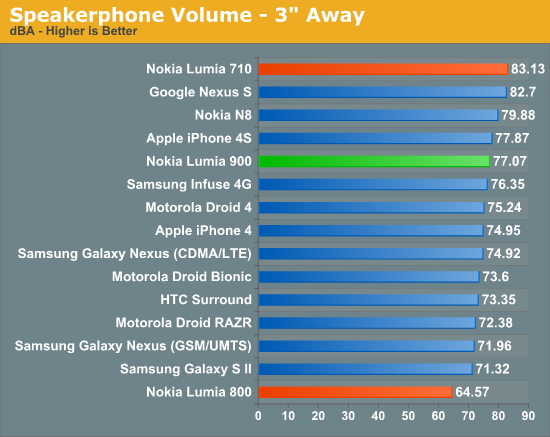
The next test is how well the Lumia 900's noise rejection works, which uses the second microphone at the very top in conjunction with the primary microphone in the speakerphone grille at bottom to do some common mode noise rejection. To test this I did what I always do and placed a call between the Lumia 900 and another AT&T phone (AMR-NB) and recorded the output of that call while increasing the volume of some music and decreasing it.
The results are excellent, as even at maximum volume I have a hard time discerning the background sound at all. I suspect that Nokia is using the Fluence noise rejection provided onboard the Qualcomm SoC, but I'm still not completely certain.


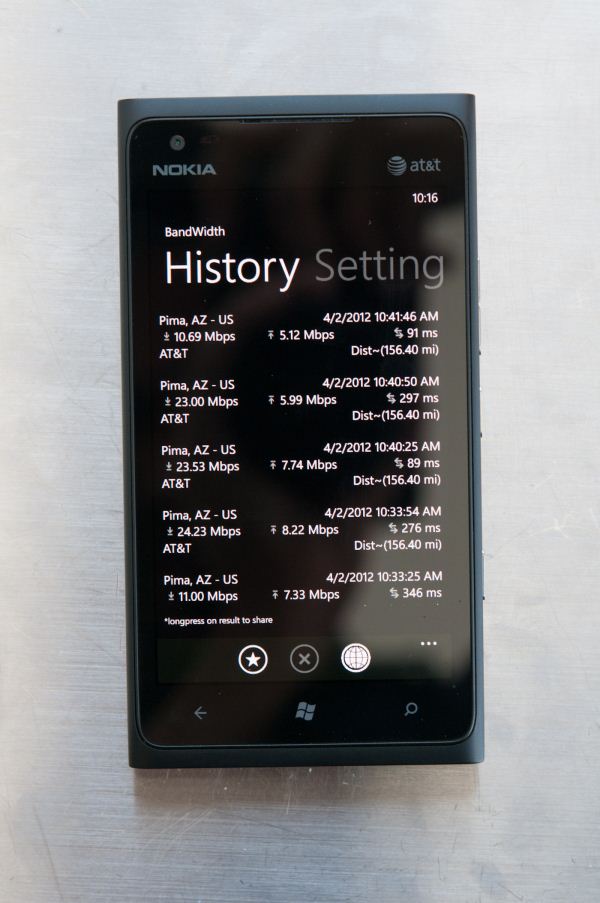
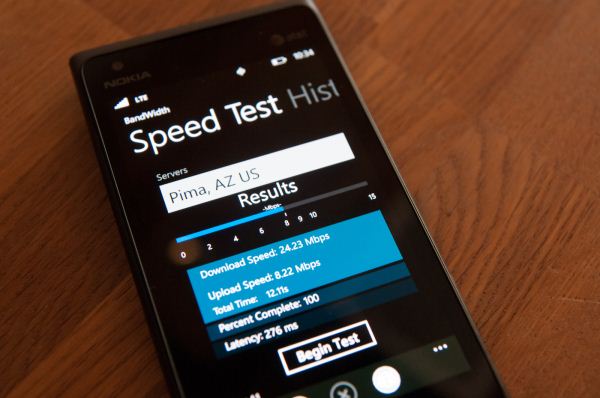
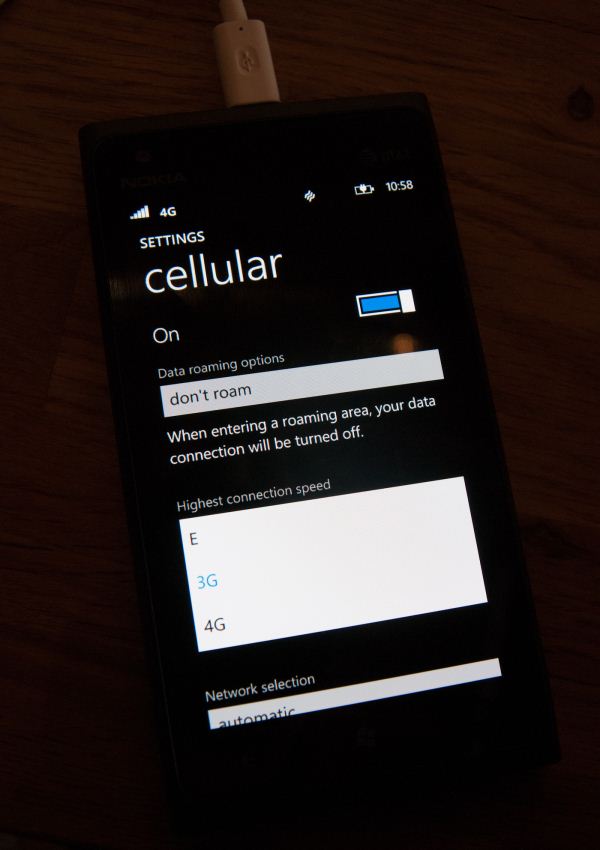
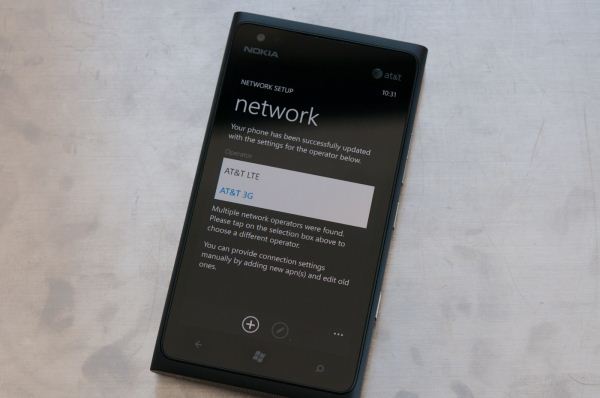








128 Comments
View All Comments
tipoo - Wednesday, April 4, 2012 - link
It seems to me like Microsoft is deliberately capping WP7 phones so that Apollo phones will look even better by comparison, with the SoC single core limitations and screen resolution caps. I wonder if this phone or other WP7 phones will be able to get WP8 then, or if that will only be on dual core phones?melgross - Wednesday, April 4, 2012 - link
The OS can't handle multi cores or a higher Rez. That's just the way it is. Since that's going to limit sales, why would they deliberately want to do that?Yes, there's a fork of CE (which is what WP7 uses), which allows dual cores, but it has it's own problems as a phone OS.
tipoo - Wednesday, April 4, 2012 - link
But I'm still wondering if current phones will be able to get WP8. Since it has a new kernel, my guess would be no.N4g4rok - Wednesday, April 4, 2012 - link
It's possible, but my not be a profitable. There's always that ugly little trade off between going next generation or supporting legacy hardware.I think what they do with it will depend on how different the OS itself is in terms of features and UI. If it brings an entirely new suite of capabilities that would not be as efficient on single-core platforms, then it might not hurt to let the previous generation to go to pasture. Otherwise, they might loose that regard as an efficient handset.
Then again, who knows if the kernel in Apollo will be built with the intension to utilize dual core hardware, or if the upgraded hardware will be mainly for drawing attention from developers.
Braumin - Wednesday, April 4, 2012 - link
I don't think the kernel will matter. The new kernel will support far more hardware than the old one.When you upgrade your PC from Windows XP to Windows 7, the kernel changes, but the hardware doesn't.
I assume that since basically there are only a couple of different hardware specs for WP7, they will make it possible. The question of course is whether the hardware vendor will bother with the upgrade. In most cases, I would say no, but I also think Nokia will be the exception.
We'll see in the fall though!
ol1bit - Wednesday, April 4, 2012 - link
Yea, Microsoft is way behind in the phone game. They need to keep up, how long have they been play with WP7 now, and still no high rez or multi-core?I think MS continues to make bad decisions. Who wanted a single threaded OS 3 years ago? They just looked at Apple current and said we like that, and lets design ours just like that.
Goggle looks to the future and started Android out multi-threaded. I hope Alppol isn't a hack job with fake multi-threading added in.
robco - Wednesday, April 4, 2012 - link
The $99 price point is interesting, same as the iPhone 4, but with more storage and LTE. I suppose that works since they're still behind the 4S a bit.I like WP7 and if I decide to ditch iOS, it would be my next choice. I just hope MS will support more chipsets and higher display resolutions sooner rather than later. Of course the big issue for me, and others in this area, is the carrier issue in the US. I won't go back to AT&T. For many people the reception is fine and the service tolerable, but not where I live. So far the only WP7 handsets on Sprint or VZW are even more dated.
MS has a lot of ground to gain, but it's not as if they don't have the resources to throw at it...
NeoteriX - Wednesday, April 4, 2012 - link
Brian,Your insight into the display, and in particular, digging up the optical path of the ClearBlack technology, may be overlooked by many. But it's really something where your obvious optics education/background gives you and AnandTech significant added value over the droves of blathering nontechnical review sites and blogs.
Kudos.
EddyKilowatt - Wednesday, April 4, 2012 - link
If this is the kudos section, let me award one too, for posting and discussing the MediaInfo screencap showing the video and audio codec settings. That too is the kind of non-blathering, solid tech info that I'm glad you guys specialize in.(I actually googled "lumia 900 video bitrate"... and must confess I grinned a knowing grin when I saw AnandTech pop up in the first screen of hits.)
name99 - Wednesday, April 4, 2012 - link
"Interestingly enough Nokia does note the presence of Rx diversity for WCDMA on the Lumia 900 front and center, both under their “design” tab and under Data Network on the specifications page. It’s awesome to see another handset vendor realize that great cellular performance is noteworthy"I'm rather more cynical than you. Note that they do NOT support HSPA MIMO.
My guess is that at least part of talking up their diversity antenna is specifically to deflect from that --- throw out some techno-lingo about how we have multiple antennas to "maximize RF performance" and hope no-one notices some conspicuous holes in our HSPA features.